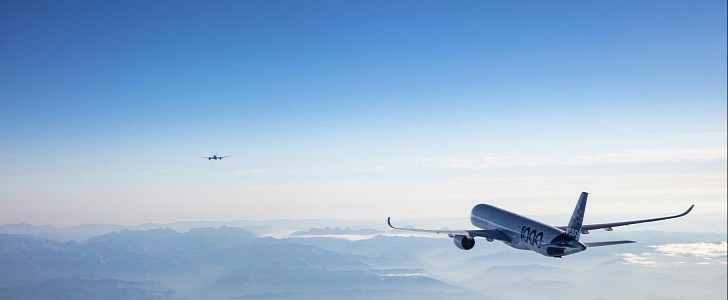There are two main things we hear about regarding the future of sustainable aviation: alternative fuels and electric aircraft. Unfortunately, both are still controversial and require small steps, so it will be a while until they can start making a real impact on climate change. But what if there were other ways of reducing aircraft emissions, which could be implemented faster and easier?
Nature is still an invaluable source of inspiration for technology developments related to movement, in general. For example, some of the most advanced robots were designed using concepts inspired by natural movement mechanisms. This is known as biomimicry (the design of structures and systems inspired by nature), and it’s an essential part of a pioneering project developed by Airbus.
Airbus UpNext, an Airbus subsidiary that’s helping fast-track technology innovations, has initiated a flight demonstrator project exploring the benefits of flight formation in 2019. The final demonstration flight was performed recently, confirming the outstanding results of this truly unique solution.
Instead of changing aircraft design or fuels, this project brings a new perspective on lower-emissions aviation: formation flight. The principle was inspired by large migrating birds that fly in the well-known V-shaped formation. Similarly, an aircraft that flies in the wake updraft of a leading aircraft could significantly reduce engine thrust and fuel consumption.
The final demonstration was carried out by two A350 test airplanes, which flew in formation in general air traffic (GAT) regulated transatlantic airspace. The two flew with a 1.8 miles (3 km) distance between them, from Toulouse (France) to Montreal (Canada). The result? A 6-ton cut in CO2 emissions during the trip.
According to Airbus, these results confirm that this method could lead to a 5% fuel saving on long-haul flights.
It sounds simple, but the project also involved working on specific flight control systems, not only for the best results but also for the safety of the following aircraft. Together with navigations service providers and air traffic management partners, the aviation company successfully demonstrated that “wake energy retrieval flight technology” can be used without safety risks.
The project developers say that “fello’fly” can revolutionize civil aviation if it is implemented across the industry.
Airbus will now move on to obtaining certification for the fello’fly operational concept and hopes to implement it for passenger flights by the middle of this decade.
Airbus UpNext, an Airbus subsidiary that’s helping fast-track technology innovations, has initiated a flight demonstrator project exploring the benefits of flight formation in 2019. The final demonstration flight was performed recently, confirming the outstanding results of this truly unique solution.
Instead of changing aircraft design or fuels, this project brings a new perspective on lower-emissions aviation: formation flight. The principle was inspired by large migrating birds that fly in the well-known V-shaped formation. Similarly, an aircraft that flies in the wake updraft of a leading aircraft could significantly reduce engine thrust and fuel consumption.
The final demonstration was carried out by two A350 test airplanes, which flew in formation in general air traffic (GAT) regulated transatlantic airspace. The two flew with a 1.8 miles (3 km) distance between them, from Toulouse (France) to Montreal (Canada). The result? A 6-ton cut in CO2 emissions during the trip.
According to Airbus, these results confirm that this method could lead to a 5% fuel saving on long-haul flights.
It sounds simple, but the project also involved working on specific flight control systems, not only for the best results but also for the safety of the following aircraft. Together with navigations service providers and air traffic management partners, the aviation company successfully demonstrated that “wake energy retrieval flight technology” can be used without safety risks.
The project developers say that “fello’fly” can revolutionize civil aviation if it is implemented across the industry.
Airbus will now move on to obtaining certification for the fello’fly operational concept and hopes to implement it for passenger flights by the middle of this decade.






